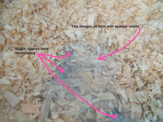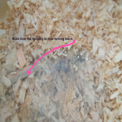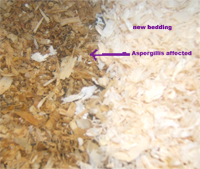| |
Aspergillis Fungus
There are over 150 species in the Aspergillus genus fungi (moulds) that are found worldwide. It is a filamentous fungus made of chains of cells called Hyphae. Its natural habitat is in hay and composts. A small number of these fungi can be found indoors and some are potentially pathogenic. These fungi are agents capable of causing disease which is harmful to the health of humans and animals. Most people are naturally immune to the effects of aspergillus, only people with an already weakened immune system or those that suffer other lung conditions are susceptible to the effects of aspergillus fungus.
Aspergillus grows only in environments lacking a carbon source. Instead it uses salts and nitrogen sources such as ammonia and nitrate for both growth and protein production.
Aspergillis fungus is highly detrimental to the health of your hamster and like any fungi it can grow at an alarming rate. Mould growths can be detected visibly by discovering growths that appear similar to a white cotton wool like growth.
But as the hamster moves about in the substrate the fungus may become mixed in with the bedding and therefore may not be so visible. A common indicator that there is a problem with aspergillus may be the detection of a strong musty odour. The fungus may not actually be seen in its early stages until the bedding / substrate starts to discolour and may turn black.
Before it gets to this stage the hamster through his exceptional keen sense of smell will know it is there. He may then try to dispose of the affected bedding in the only way he can, this is usually by pushing or piling it high it in a corner of the cage.
A hamster that has been diagnosed as being diabetic or having a bladder or kidney infection is most at risk when exposed to the aspergillis fungus. Even healthy hamsters may be put at risk by the inhaling the microscopic airborne spores of this deadly fungus.
Aspergillis fungus gives off a very strong musty odour and produces airborne spores; it is at this stage when the aspergillis fungus spores become airborne that the fungus is able to spread and will begin to cause problems with the hamsters breathing.
After this fungus first appears and the hamster develops any symptoms such as diarrhea, wheezing, sneezing, skin irritation, generally run down or lethargic then see your vet immediately.
Aspergillis fungus is very easy to prevent or eradicate, basic cage hygiene is all that is needed, and as long as the cage floor is kept dry any breeding ground for this potentially deadly fungus will be eliminated.
Aspergillis will flourish where it is warm and humid. At first the fungus appears as a white or grey cotton wool type growth, this will quickly turn black and spread rapidly throughout the cage if not removed.
Symptoms or the first signs of your hamster being affected by the aspergillis fungus spores are the onset of laboured breathing accompanied by wheezing.
Click to enlarge images

The white fungus in it's early stages
|

Note how the fungus is now turning black
|

Note the difference between the two |
Preventing aspergillis
The majority of mould and fungi reproduce by producing spores: Spores are microscopic cells that can become airborne very easily. These spores then attach themselves to surfaces that are wet and new growths called colonies form if the right conditions prevail. The ideal conditions for growth include high humidity and moisture content. The ideal temperature range for mould growth is between 50 and 85 degrees Fahrenheit, and this is the usual temperature range that hamsters are usually kept in. Mould is unable to grow in the absence of moisture, but when the spores settle on a damp surface they begin to germinate and produce a branching network called hyphae the mould then begins digesting the surface they attach to in order to survive.
To eradicate or prevent the fungus from developing is very simple; all that is needed is to practice basic cage hygiene. Aspergillis fungus thrives on salts and nitrogen sources. Urine is an aqueous solution of metabolic wastes such as dissolved salts and organic compounds and nitrate; this is produced in the hamster’s urine, making a good breeding ground for fungus. The area where the hamster urinates should be cleaned at least once a week along with the rest of the cage, it is not necessary to use any anti fungal treatments or disinfectant just hot water together with a mild detergent and a good scrub is sufficient.
Try not to leave any fresh foods fruits or vegetables lying around the cage any longer than necessary, including any that may have been stored or hidden away by the hamster. All uneaten fresh food should be removed between feeds, or removed in a period of no longer than 24 hours maximum. This will prevent the onset of aspergillus, and other fungus growths.
Leaking or a dripping water bottle can leave the bedding wet and foster a breeding ground for fungus.
The appearance of the fungus if left untouched will appear as a white fur like growth on top of the bedding in the cage.
But as the hamster is moving around it may not be quite as noticeable as the fungus will become mixed with the floor covering. The first visual signs of any problem with fungus will be as it starts to discolour the bedding, but a more noticeable smell of the fungus may appear long before any discoloration this is usually noted by a very strong and musty odour.


|
|


